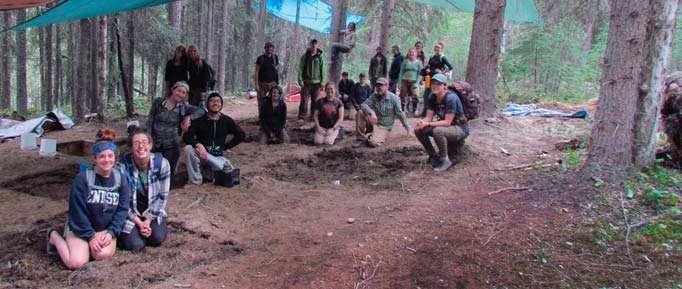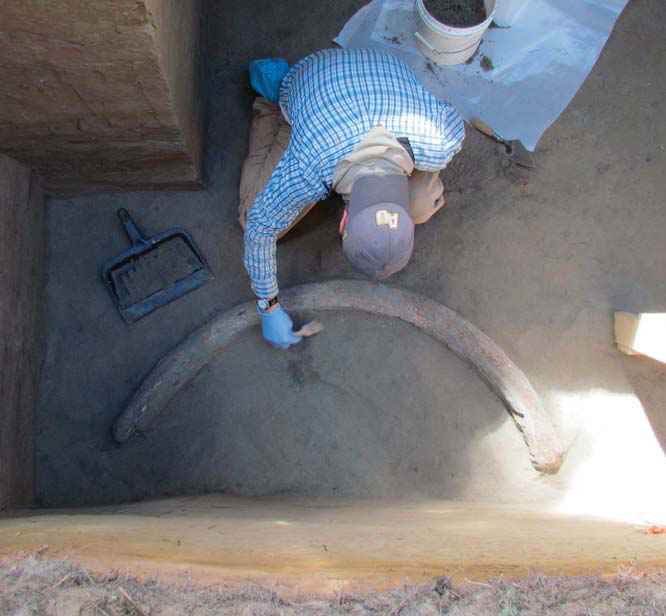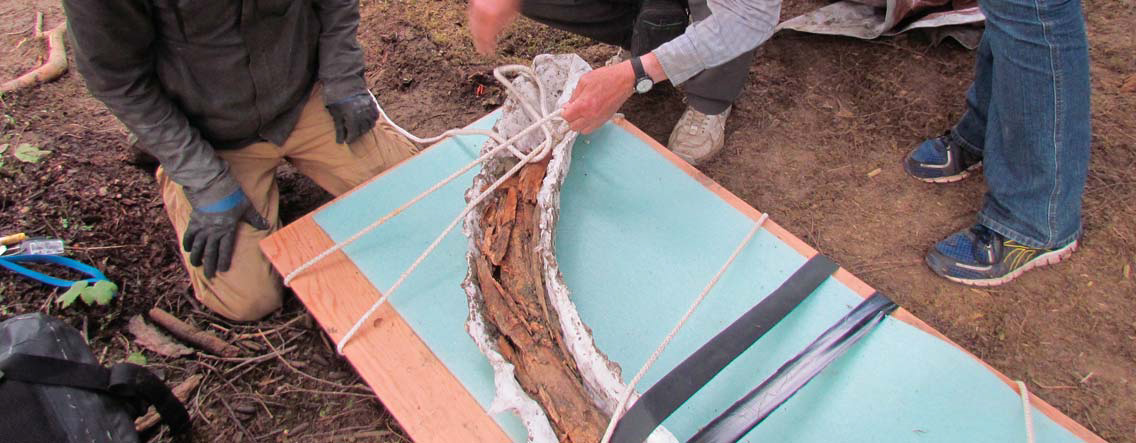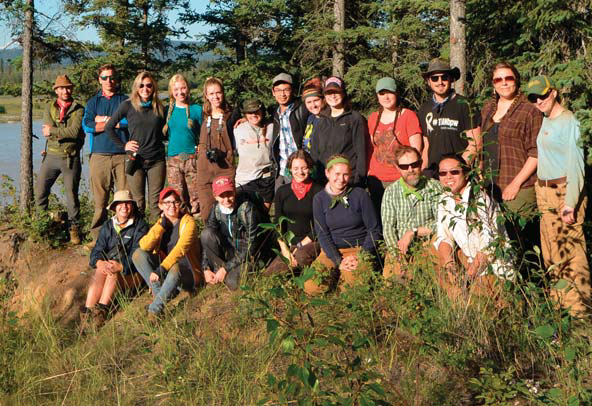Archaeological digs are hit-or-miss propositions. Often you find nothing. Sometimes a theory is confirmed. Once or twice in a career, you unearth the unexpected.
Adelphi professors unearth a tantalizing clue that captures worldwide attention
Archaeological digs are hit-or-miss propositions. Often you find nothing. Sometimes a theory is confirmed. Once or twice in a career, you unearth the unexpected.
Associate Professor Brian Wygal, Ph.D., and Kathryn Krasinski, Ph.D., a part-time faculty member in Adelphi’s anthropology department, made one of those rare and exciting discoveries in the summer of 2016. While leading a group of students at the university’s Alaska field school, they found a virtually complete, 14,000-year-old tusk of what may have been one of the last woolly mammoths on the Alaska mainland.

More than an archaeological dig, the field school is an opportunity to live in the Alaskan wilderness and have the adventure of a lifetime.
It was a find that attracted worldwide attention, with coverage in Archaeology magazine, numerous science publications, Yahoo! News and the BBC. The reason is that the discovery may shed light on a mystery that has long baffled archaeologists: Why did the mammoth become extinct?
Dr. Wygal and Dr. Krasinski didn’t go to Alaska to answer that question. Rather, they sought evidence that could be used to develop a greater understanding of the first humans in North America, hunter-gatherers who came to the continent from North Asia in the late Pleistocene era.
The 2016 dig, located at the Holzman archaeological site 70 miles southeast of Fairbanks, certainly contributed to that understanding. It produced a trove of artifacts reaching back 13,600 years, including evidence of campfires, bones of large mammals and stone tools. Dr. Wygal and Dr. Krasinski also found small pieces of mammoth ivory, and tools made of it, on the site, suggesting that the first humans in North America went out of their way to acquire mammoth ivory.

The 14,000-year-old woolly mammoth tusk is the largest ever found in Alaska on a site associated with humans. Its presence holds clues to the history of the first Americans and their possible role in the mammoths’ extinction.
The tusk found among these artifacts is the largest ever associated with humans in Alaska. Given the approximate ages of the findings, Dr. Wygal and Dr. Krasinski wondered whether the people of the unearthed encampment scavenged the tusk from the landscape or hunted and killed the beast.
That question goes to the heart of the mystery of mammoth extinction, which is still debated by scholars across the globe: Was extinction caused by environmental change at the end of the Ice Age, by overhunting or by a combination of the two?
Mammoths flourished in Siberia and North America during the Ice Age, which was at its coldest 22,000 years ago. As the Earth’s climate warmed over the next 10,000 years, the mammoth’s habitats underwent significant changes. By the end of that time of “rapid” warming, the animals were virtually extinct.
Chemical analysis of the tusk can provide valuable information about any environmental factors that may have led to extinction. Information about the animal’s health and diet, for example, can illustrate the landscape during a time of rapid climate change. “Were mammoths getting enough food at that time?” Dr. Wygal asked. “Was vegetation changing into something mammoths couldn’t eat? And did the introduction of humans into a changing, possibly stressed environment push the animals over the edge? Analysis of the tusk can help us begin finding answers.”

Chemical analysis of the tusk can provide valuable information on the animal’s health and diet and what led to the extinction of the mammoth.
The closeness in age of the tusk and the remains of the human encampment offer tantalizing clues about the role humans may have played in mammoth extinction.
“If we really want to know what happened to the mammoths, we need to find mammoths that were contemporaneous with people,” Dr. Krasinski explained. “That helps us understand how much hunting was going on and how important mammoths were to the first Alaskans.”
“This tusk actually gets us there,” she continued. “It’s about the same age as the campfires at the site. At most other sites, all you can infer is that humans were scavenging old ivory. That isn’t the case here, although we still have some work to do to demonstrate that.”
Dr. Wygal and Dr. Krasinski returned to the site in the summer of 2017 to further explore the part humans played in the decline of the mammoth and advance their understanding of the first Americans.
Prior to departing back to Alaska, Dr. Wygal said, “We don’t know what we’ll uncover, but whatever we find will help fill a gap in the chronology of human history. The peopling of North America was the last chapter in major continental colonization by people coming out of Africa. We want to know more about the first Americans—where they came from, when they arrived, whether they came in small groups or one big migration, and whether they traveled south to people the area now known as the United States over a coastal route or an interior path.”
There are no definitive answers to these questions, only contentious debates—including arguments that humans came to present-day America from France rather than Asia.
Dr. Wygal’s position on the issue is steadfast, which explains why he and Dr. Krasinski are so passionate about their fieldwork. “Alaska,” he said, “holds the key to the timing and route of the first Americans.”

Students throughout North America seek out Adelphi’s Alaska Field School.
deglaciation and human colonization, human ecology, technological organization and issues surrounding First Americans. Instrumental in the founding of the Adelphi Archaeological Field School in Alaska, he is also an advocate of bringing new technologies into the classroom and in fieldwork. Dr. Wygal and his students have used global positioning technology to build precise maps, mark and catalogue locations, and excavate in the Alaskan wilderness. Kathryn Krasinski, Ph.D., focuses her research around hunter-gatherer subsistence, zooarchaeology, vertebrate taphonomy and peopling of the Americas, subarctic Alaska and southern Africa. She earned her doctorate in prehistoric archaeology from the University of Nevada-Reno. With Dr. Wygal, Dr. Krasinski is a key part of giving Adelphi students hands-on experience at Alaskan archeological digs.
For further information, please contact:
Todd Wilson
Strategic Communications Director
p – 516.237.8634
e – twilson@adelphi.edu